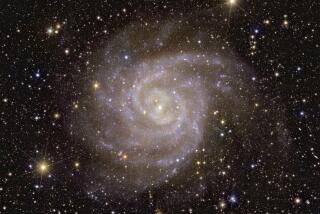Hopes High for a 3-D Road Map to Final Frontier : Space: Astronomers are ready to embark on a mission to chart the universe in greater detail than ever before. The project is expected to take 10 years.
- Share via
An ambitious effort to map the universe 100 times more thoroughly than ever before will be announced today by astronomers from a consortium of universities.
The project will use a new telescope to be built atop Apache Peak in New Mexico. The goal of the 10-year venture is to produce a three-dimensional map of 1 million galaxies and other celestial targets that will give scientists their best opportunity yet to understand the large-scale structure of the universe.
A traditional image of the sky is two dimensional: a flat portrait that does not reveal the depth and positioning of stars, which is essential to understanding how some galaxies form giant structures. In recent years, for example, scientists have discovered collections of stars and galaxies that form a wall millions of light years long. Other astronomers have discovered that the universe appears to be made up of giant bubbles with stars and galaxies surrounding great voids.
Since the universe presumably began with the Big Bang, which should have distributed matter uniformly throughout space, scientists are struggling to explain why matter eventually evolved into the great structures now being discovered.
The new survey also will include 100,000 quasars, mysterious objects about the size of the solar system but that shine more brightly than entire galaxies, and numerous gas clouds that could be either the remnants of exploding stars or future stars in the process of forming. The result should be a portrait of the universe that reveals the interrelationship and true form of various great structures.
The survey, expected to cost $14 million, “is the cosmic equivalent of a U.S. Geological Survey map,” said Richard Kron, professor of astronomy and astrophysics at the University of Chicago and director of the Yerkes Observatory in Wisconsin. “It will show details of galaxy and quasar distribution as well as the large scale ‘geography’ of the universe.”
“Nobody has ever made such an elegant and detailed map of the sky,” said Bruce Margon, chairman of astronomy at the University of Washington and chairman of the Astrophysical Research Consortium, which is sponsoring the project. The survey will be conducted by scientists from the University of Chicago, the Institute for Advanced Study and Princeton University.
Other members of the consortium are New Mexico State University, Washington State University and the University of Washington. In addition, the Fermi National Accelerator Laboratory is expected to provide computers and programs that will make it possible for scientists to collect and analyze 10 million megabytes of information.
The cornerstone of the project is a new, wide-field, 2.5 meter telescope that will be operational by 1995. Most modern telescopes use light-sensitive computer chips called “charge-coupled devices” that count the photons of light hitting the mirror, thus greatly increasing their sensitivity. This new camera will have 30 such sensors and will be able to record 120 million points of light at one time.
The astronomers hope to complete the survey in about five to seven years after the project begins.






